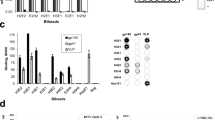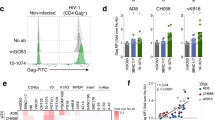Abstract
The identification of fusin and other chemokine receptors as coreceptors for HIV-1 has renewed the interest in agents that may prevent viral entry. Polyanionic compounds such as dextran sulfate, curdlan sulfate, and suramin act on the V3 loop of the viral envelope and may prevent its interaction with fusin. These agents show activity against a wide range of HIV-1 strains, but have undesirable circulating half-life, bioavallability, and toxicity. We have developed a small molecule inhibitor of HIV-1 that has several advantages over these other agents. FP-21399 is a novel compound of the bis(disulfonaphthalene) dimethoxybenzene class that blocks entry of HIV into CD4+ cells and blocks fusion of infected and noninfected CD4+ cells. This compound only weakly inhibits binding of CD4 and gp120, at concentrations much greater than are required to block viral entry. Furthermore, FP-21399 can block the interaction between gp120 and antibodies directed against the V3 loop, but does not block binding of antibodies directed against the V4 loop. Animal studies demonstrate that FP-21399 is concentrated in lymph nodes, making It a promising compound for anti-HIV therapy. In SCID mice reconstituted with human immune cells, maintenance of HIV-1 infection was blocked by a 5-day treatment with low doses of FP-21399, suggesting that lymph node accumulation may contribute to antiviral activity. Finally, attempts to generate drug-resistant virus in cell culture resulted in only weakly resistant variants with IC90values that are much lower than concentrations of FP-21399 found in lymph nodes.
This is a preview of subscription content, access via your institution
Access options
Subscribe to this journal
Receive 12 print issues and online access
$209.00 per year
only $17.42 per issue
Buy this article
- Purchase on Springer Link
- Instant access to full article PDF
Prices may be subject to local taxes which are calculated during checkout
Similar content being viewed by others
References
Rusche, J.R., Jahaverian, K., McDanal, C., Petro, J., Lynn, D.L., Grimaila, R., et al. 1988. Antibodies that inhibit fusion of human immunodeficiency virus-infected cells bind a 24-amino acid sequence of the viral envelope, gp120. Proc. Nat. Acad. Sci. 85: 3198–3202.
Palker, T.J., Clark, M.E., Langlois, A.G., Matthews, T.J., Weinhold, K.J., Randall, R.R., et al. 1988. Type-specific neutralization of the human immunodeficiency virus with antibodies to env-encoded synthetic peptides. Proc. Nat. Acad. Sci. 85: 1932–1936.
Matsushita, S., Robert-Guroff, M., Rusche, J., Koito, A., Hattori, T., Hoshino, H., et al. 1988. Characterization of a human immunodeficiency virus neutralizing monoclonal antibody and mapping of the neutralizing epitope. J. Virol. 62: 2107–2114.
Skinner, M.A., Ting, R., Langlois, A.J., Weinhold, K.J., Lyerly, H.K., and Matthews, T.J. 1988. Characteristics of a neutralizing monoclonal antibody to the HIV envelope glycoprotein. AIDS Res. Hum. Retroviruses 4: 187–194.
Kinney-Thomas, E., Weber, H.N., McClure, J., Clapham, P.R., Singhal, M.C., Shiver, M.K., et al. 1988. Neutralizing monoclonal antibodies to the AIDS virus. AIDS 2: 25–29.
Chang, R.S., Tabba, H.D., He, Y., and Smith, K.M. 1988. Dextran sulfate as an inhibitor against the human immunodeficiency virus. Proc. Soc. Exp. Blol. Med. 189: 304–309.
Callahan, L.N., Phelan, M., Mallinson, M., and Norcross, M.A. 1991. Dextran sulfate blocks antibody binding to the principal neutralizing domain of human immunodeficiency virus type I without interfering with gp120-CD4 interactions. J. Virol. 65: 1543–1550.
Baitinic, D. and Robey, F.A. 1992. The V3 region of the envelope glycoprotein of human immunodeficiency virus type 1 binds sulfated polysaccharides and CD4-derived synthetic peptides. J. Biol. Chem. 267: 6664–6671.
Levine, A.M., Gill, P.S., Cohen, J., Hawkins, J.G., Formenti, S.C., Aguilar, S., et al. 1986. Suramin antiviral therapy in the acquired immunodeficiency syndrome. Ann. Intern. Med. 105: 32–37.
Aoki, T., Kaneko, Y., Nguyen, T., Stefanski, M.S., Ting, R.C.Y., and Manak, M.M. 1992. Curdlan sulfate and HIV-1: II. In vitro long-term treatment of HIV-1 infection with curdlan sulfate. AIDS Res. Hum. Retroviruses 8: 605–613.
Cardin, A.D., Smith, P.L., Hyde, L., Blankenship, D.T., Bowlin, T.L., Schroeder, K., et al. 1991. Stilbene disulfonic acids: CD4 antagonists that block human immunodeficiency virus type-1 growth at multiple stages of the virus life cycle. J. Biol. Chem. 266: 13355–13363.
Clanton, D.J., Moran, R.A., McMahon, J.B., Weislow, O.S., Buckheit, R.W.J., Hollingshead, M.G., et al. 1992. Sulfonic acid dyes: inhibition of the human immunodeficiency virus and mechanism of action. J. AIDS 5: 771–781.
Wyatt, J.R., Vickers, T.A., Roberson, J.L., Buckheit, R.W.J., Klimkait, T., DeBaets, E., et al. 1994. Combinatorially selected guanoslne-quartet structure is a potent inhibitor of human immunodeficiency virus envelope-mediated cell fusion. Proc. Natl. Acad. Sci. 91: 1356–1360.
Mohan, P., Sun, D., Thornton, A., and Sari, P.S. 1990. Inhibition of HIV replication by derivatives of naphthalenedisulfonic acids. AIDS 4: 821–822.
Mohan, P., Singh, R., and Baba, M. 1991. Potential anti-AIDS agents. Synthesis and antiviral activity of naphthalenesulfonic acid derivatives against HIV-1 and HIV-2. J. Mod. Chem. 34: 212–217.
Flexner, C., Barditch-Crovo, P.A., Kornhauser, D.M., Farzadegan, H., Nerhood, L.J., Chaisson, R.E., et al. 1991. Pharmacokinetics, toxicity, and activity of intravenous dextran sulfate in human immunodeficiency virus infection. Antimicrob. Agents Chemother. 35: 2544–2550.
Feng, Y., Broder, C.C., Kennedy, P.E., and Berger, E.A. 1996. HIV-1 entry cofactor functional cDNA cloning of a seven-transmembrane, G protein-coupled receptor. Science 272: 872–877.
Deng, H.-K., Liu, R., Ellmeier, W., Choe, S., Unutmaz, D., Brukhart, M., et al. 1996. Identification of a major co-receptor for primary isolates of HIV-1. Nature 381: 661–666.
Dragic, T., Litwin, V., Allaway, G.P., Martin, S.R., Huang, Y., Nagashima, K.A., et al. 1996. HIV-1 entry Into CD4+ cells is mediated by the chemokine receptor CC-CKR-5. Nature 381: 667–673.
Doranz, B.J., Rucker, J., Yanjie, Y., Smyth, R.J., Samson, M., Peiper, S.C., et al. 1996. A dual-tropic primary HIV-1 isolate that uses fusin and the β-chemokine receptors CKR-5, CKR-3, and CKR-2b as fusion cofactors. Cell 85: 1149–1158.
Choe, H., Farzan, M., Sun, Y., Sullivan, N., Rollins, B., Ponath, P.D., et al. 1996. The β-chemokine receptors CCR3 and CCR5 facilitate infection by primary HIV-1 Isolates. Cell 85: 1185–1148.
Ho, D.D., Neumann, A.U., Perelson, A.S., Chen, W., Leonard, J.M., and Markowltz, M. 1995. Rapid turnover of plasma virions and CD4 lymphocytes in HIV-1 infection. Nature 373: 123–126.
Wei, X., Ghosh, S.K., Taylor, M.E., Johnson, V.A., Emini, E.A., Deutsch, P., et al. 1995. Viral dynamics In human immunodeficiency virus type 1 infection. Nature 373: 117–122.
Embretson, J., Zupancic, M., Ribas, J.L., Burke, A., Racz, P., Tenner-Racz, K., et al. 1993. Massive covert infection of helper T lymphocytes and macrophages by HIV during the incubation period of AIDS. Nature 362: 359–362.
Pantaleo, G., Graziosi, C., Demarest, J.F., Butini, L., Montroni, M., Fox, C.H., et al. 1993. HIV Infection is active and progressive in lymphoid tissue during the clinically latent stage of disease. Nature 362: 355–358.
Fauci, A. 1993. Multlfactorial nature of human immunodeficiency virus disease: implications for therapy. Science 262: 1011–1018.
Traunecker, A., Luke, W., and Karjalainen, K. 1988. Soluble CD4 molecules neutralize human immunodeficiency virus type 1. Nature 331: 84–86.
Smith, D.H., Byrn, R.A., Marsters, S.A., Gregory, T., Groopman, J.E., and Capon, D.J. 1987. Blocking of HIV-1 infectivity by a soluble, secreted form of the CD4 antigen. Science 235: 1704–1707.
Hussey, R.E., Richardson, N.E., Kowalski, M., Brown, N.R., Chang, H.-C., Siliciano, R.F., et al. 1988. A soluble CD4 protein selectively inhibits HIV replication and syncitium formation. Nature 331: 78–81.
Thali, M., Furman, C., Helseth, E., Repke, H., and Sodroski, J. 1992. Lack of correlation between soluble CD4-lnduced shedding of the human immunodeficiency virus type 1 exterior envelope glycoproteln and subsequent membrane fusion events. J. Virol. 66: 5516–5524.
Lin, P.-F., Simanta, H., Bechtold, C.M., Deminie, C.A., Patick, A.K., Alam, M., et al. 1996. Characterization of siamycin I, a human immunodeficiency virus fusion inhibitor. Antimicrob. Agents Chemother. 40: 133–138.
Uryu, T., Kaneko, Y., Yoshida, T., Mihara, R., Shoji, T., Katsuraya, K., et al. 1993. pp. 101–115 in Carbohydrates and carbohydrate polymers: analysis, biotechnology, modification, antiviral, blomedlcal, and other applications. Yalpani, M. (ed.). ATL Press, Shrewsbury, MA.
McCune, J.M., Namikawa, R., Shih, C.C., Rabin, L., and Kaneshima, H. 1990. Suppression of HIV infection in AZT-treated SCID-hu mice. Science 247: 564–566.
Romero, D.L., Busso, M., Tan, C.K., Reusser, F., Palmer, J.R., Poppe, S.M., et al. 1991. Non-nucleoside reverse transcriptase inhibitors that potently and specifically block human immunodeficiency virus type 1 replication. Proc. Natl. Acad. Sci. 88: 8806–8810.
Japour, A.J., Mayers, D.L., Johnson, V.A., Kuritzkes, D.B., Beckett, L.A., Arduino, J.-M., et al. 1993. The RV-43 Study Group, and The ACTG Virology Committee Resistance Working Group. Standardized peripheral blood mononuclear cell culture assay for determination of drug susceptibilities of clinical human immunodeficiency virus type I isolates. Antimicrob. Agents Chemother. 37: 1095–1101.
Douglas, S.D. and Hassan, N.F. 1990. pp. 858–868? in Hemotology. Williams, W.J., Beutler, E., Erslev, A.J., and Lichtman, M.A. (eds). McGraw-HIII, New York.
Ashorn, P.A., Berger, E.A., and Moss, B. 1990. Immunodeficiency virus envelope glycoprotein/CD4-mediated fusion of nonprimate cells with human cells. J. Virol. 64: 2149–2156.
Mosier, D.E., Gulizia, R.J., Baird, S.M., Wilson, D.B., Spector, D.H., and Spector, S.A. 1991. Immunodeficiency virus infection of human-PBL-SCID mice. Science 251: 791–794.
Author information
Authors and Affiliations
Rights and permissions
About this article
Cite this article
Ono, M., Wada, Y., Wu, Y. et al. FP-21399 blocks HIV envelope protein-mediated membrane fusion and concentrates in lymph nodes. Nat Biotechnol 15, 343–348 (1997). https://doi.org/10.1038/nbt0497-343
Received:
Accepted:
Issue Date:
DOI: https://doi.org/10.1038/nbt0497-343
This article is cited by
-
Giant values obtained for first hyperpolarizabilities of methyl orange: a DFT investigation
Theoretical Chemistry Accounts (2019)
-
Electrochemical behavior and in-vitro antimicrobial screening of some thienylazoaryls dyes
Chemistry Central Journal (2017)



